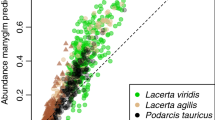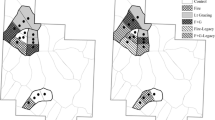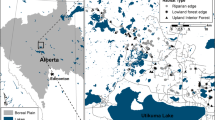Abstract
Riparian zones (RZs) functionally connect aquatic and terrestrial ecosystems, and have azonal and geographically widespread plant communities that differ from those of the neighboring terrestrial zone (TZ). Although well studied botanically, RZs are not well understood in terms of their terrestrial insect diversity, including grasshoppers. The Cape Floristic Region (CFR) is a global biodiversity hotspot with small rocky rivers running through highly diverse sclerophyllous vegetation. It has high levels of endemism among many taxa, including grasshoppers, making it ideal for testing the effect of azonal vegetation on grasshopper assemblages of the RZ, and determining whether conservation efforts should be focused on the RZ as well as the TZ. We determine grasshopper dispersion patterns along the RZ of an important CFR river, and compare these patterns with those of the TZ to understand the habitat occupancy relative to 27 environmental variables of the zones and geographical distribution of the grasshoppers. Forty percent of individuals we collected were CFR endemics. We found only weak differences in the grasshopper assemblages between the RZ and TZ, apparently driven by deep history, complex geomorphology, stressful environmental conditions, a diverse vegetation and land mosaic, and probable high predator pressure. There were two groups: large-sized, well-flighted, geographically widespread generalists that were overall more abundant in the RZ than TZ, and small, flightless or poorly-flighted, vegetation-specialists which are narrow-range endemics adapted to both RZ and TZ, but still more abundant in the TZ. We conclude that although the vegetation of this riparian zone may require some special conservation attention, this is not so for the grasshoppers which overall are best conserved in the TZ.




Similar content being viewed by others
References
Adu-Acheampong S, Bazelet CS, Samways MJ (2016) Extent to which an agricultural mosaic supports endemic species-rich grasshopper assemblages in the Cape Floristic Region biodiversity hotspot. Agric Ecosyst Environ 227: 52–60
Alexander G (2007). A guide to the reptiles of Southern Africa. Struik, Cape Town
Amédégnato C, Devriese H (2008) Global diversity of true and pygmy grasshoppers (Acridomorpha, Orthoptera) in freshwater. Hydrobiologia 595:535–543
Anderson MJ (2001) A new method for non-parametric multivariate analysis of variance. Austral Ecol 26:32–46
Anderson MJ (2006) Distance-based tests for homogeneity of multivariate dispersions. Biometrics 62:245–253
Bates D (2005) Fitting linear mixed models in R. Using the lme4 package. R News 5:27–30
Bazelet CS, Samways MJ (2011) Identifying grasshopper bioindicators for habitat quality assessment of ecological networks. Ecol Indicat 11:1259–1269
Bazelet CS, Samways MJ (2014) Habitat quality of grassland fragments affects dispersal ability of a mobile grasshopper, Ornithacris cyanea (Orthoptera: Acrididae). Afr Ent 22:714–725
Bidau CJ (2014) Patterns in Orthoptera biodiversity. I. Adaptations in ecological and evolutionary contexts. J Insect Biodiver 2:1–39
Bolker BM, Brooks ME, Clark CJ, Geange SW, Poulsen JR, Stevens MHH, White JSS (2009) Generalized linear mixed models: a practical guide for ecology and evolution. Trends Ecol Evol 24:127–135
Bryce SA, Hughes RM, Kaufmann PR (2002) Development of a bird integrity index: using bird assemblages as indicators of riparian condition. Environ Manag 30:294–310
Capello S, Marchese M, de Wysiecki ML (2012) Feeding habits and trophic niche overlap of aquatic Orthoptera associated with macrophytes. Zool Stud 51:51–58
Cowling RM, Gibbs Russell GE, Hoffman MT, Hilton-Taylor C (1989) Patterns of plant species diversity in southern Africa. In: Huntley BJ (ed) Biotic diversity in Southern Africa. Concepts and conservation. Oxford University Press, Cape Town, pp 19–50
Crous C, Samways MJ, Pryke JS (2013) Exploring the mesofilter as a novel operational scale in conservation planning. J Appl Ecol 50:205–214
Crous CJ, Samways MJ, Pryke JS (2014) Grasshopper assemblage response to surface rockiness in Afro-montane grasslands. Insect Cons Divers 7:185–194
Dirsh VM (1965) The African genera of Acridoidea. Anti-Locust Research Centre at the University Press, Cambridge
Dormann CF, Mcpherson JM, Arau MB, Bivand R, Bolliger J, Carl G, Davies RG, Hirzel A, Jetz W, Kissling WD, Ohlemu R, Peres-Neto PR, Schurr FM, Wilson R (2007) Methods to account for spatial autocorrelation in the analysis of species distributional data: a review. Ecography 30:609–628
Eades DC, Otte D, Cigliano MM, Braun H (2015) Orthoptera Species File. Version 5.0/5.0. http://Orthoptera.SpeciesFile.org. Accessed June 2015
Fartmann T, Krämer B, Stelzner F, Poniatowski D (2012) Orthoptera as ecological indicators for succession in steppe grassland. Ecol Indicat 20:337–344
Gandar MV (1983) Ecological notes and annotated checklist of the grasshoppers (Orthoptera: Acridoidea) of the Savanna Ecosystem Project Study Area, Nylsvley. South African National Scientific Programmes Report No. 74: 42 pp. Pretoria, South Africa
García-García PL, Fontana P, Marini L, Equihua-Martínez A, Sánchez-Escudero J, Valdez-Carrasco J, Cano-Santana Z (2008) Habitat association of orthoptera in El Cimatario National Park, Querétaro, México. J Orth Res 17:83–87
Gardiner T, Hassall M (2009) Does microclimate affect grasshopper populations after cutting of hay in improved grassland? J Insect Conserv 13: 97–102
Gardiner T, Hill J, Chesmore D (2005) Review of the methods frequently used to estimate the abundance of Orthoptera in grassland ecosystems. J Insect Conserv 9:151–173
Gardiner T, Pye M, Field R, Hill J (2002) The influence of sward height and vegetation composition in determining the habitat preferences of three Chorthippus species (Orthoptera: Acrididae) in Chelmsford, Essex, UK. J Orth Res 11:207–213
Gebeyehu S, Samways MJ (2002) Grasshopper assemblage response to a restored national park (Mountain Zebra National Park, South Africa). BiodiversConserv 11:283–304
Giliomee JH (2003) Insect diversity in the Cape Floristic Region. Afr J Ecol 41: 237–244
Grant PBC, Samways MJ (2007) Montane refugia for endemic and Red Listed dragonflies in the Cape Floristic Region biodiversity hotspot. Biodivers Conserv 16:787–805
Grant PBC, Samways MJ (2011) Micro-hotspot determination and buffer zone value for Odonata in a globally significant biosphere reserve. Biol Conserv 144:772–781
Hochkirch A, Adorf F (2007) Effects of prescribed burning and wildfires on Orthoptera in Central European peat bogs. Environ Conserv 34:1617–1625
Hothorn T, Bretz F, Westfall P (2008) Simultaneous inference in general parametric models. Biometr J 50:346–363
Innis SA, Naiman RJ, Elliot SR (2000) Indicators and assessment methods for measuring the ecological integrity of semi-aquatic terrestrial environments. Hydrobiologia 422:111–131
Joern A, Laws AN (2013) Ecological mechanisms underlying arthropod species diversity in grassland. Ann Rev Entomol 58:19–36
Johnson SD (1992) Plant–animal relationships. (ed. by ) pp. 175–205. In: Cowling RM (ed) The ecology of fynbos: nutrients, fire and diversity. Oxford University Press, Cape Town
Joubert L, Pryke JS, Samways MJ (2016) Positive effects of burning and cattle grazing on grasshopper diversity. Insect Conserv Divers 9:290–301
Key K (1937) New Acrididae from South Africa. Ann South Afr Mus 32:135–167
Lambeets K, Vanderhuchte ML, Maelfait J-P, Bonte D (2009) Integrating environmental conditions and functional life-history traits for riparian arthropod conservation planning. Biol Conserv 142:625–637
Linder HP (2003) The radiation of the Cape flora, southern Africa. Biol Rev Cambridge Philos Soc 78: 597–638
Matenaar D, Bazelet CS, Hochkirch A (2015) Simple tools for the evaluation of protected areas for the conservation of grasshoppers. Biol Conserv 192:192–199
Matenaar D, Broder L, Bazelet CS, Hochkirch A (2014) Persisting in a windy habitat: population ecology and behavioral adaptations of two endemic grasshopper species in the Cape region (South Africa). J Insect Conserv 18:447–456
Mehltreter K, Walker LR, Sharpe JM (2010) Fern ecology. Cambridge University Press, Cambridge
Mucina L, Rutherford MC (2006) The Vegetation of South Africa, Lesotho and Swaziland. South African National Biodiversity Institute, Pretoria
Naiman RJ, Beechie TJ, Benda LE, Berg DR, Bisson PA, MacDonald LG, O’Connor MD, Olson PL, Steel EA (1992) Fundamental elements of ecologically healthy watersheds in the Pacific Northwest coastal ecoregion. In: Naiman RJ (ed) Watershed management: balancing sustainability and environmental change. Springer, New York, pp 127–1885
Naiman RJ, Decamps H (1990) The ecology and management of aquatic-terrestrial ecotones. Parthenon, UNESCO, Carnforth, Paris
Naiman RJ, Decamps H, Pollock M (1993) The role of riparian corridors in maintaining regional biodiversity. Ecol Appl 3: 209–212
Naskrecki P, Bazelet CS (2009) A species radiation among South African flightless spring katydids (Orthoptera: Tettigoniidae: Phaneropterinae: Brinckiella Chopard). Zootaxa 2056:46–62
Nelson SM (2007) Butterflies (Papilionoidea and Hesperioidea) as potential ecological indicators of riparian quality in the semi-arid western United States. Ecol Indicat 7:469–480
Nelson SM, Andersen DC (1994) An assessment of riparian environmental quality by using butterflies and disturbance susceptibility scores. Southwest Nat 39:137–142
Nilsson C (1992) Conservation management of riparian communities. In: Hansson L (ed) Ecological principles of nature conservation. Elsevier, Amsterdam, pp 352–372
PRIMER-E (2009) Primer 6 version 6.1.13 and Permanova + version 1.0.3. Primer-E, Ltd
Paetzold A, Schubert CJ, Tockner K (2005) Aquatic-terrestrial linkages along a braided river: riparian arthropods feeding on aquatic insects. Ecosystems 8:748–759
Paetzold A, Yoshimura C, Tockner K (2008) Riparian arthropod responses to flow regime regulation and river channelization. J Appl Ecol 45:894–903
Pfadt RE (1981) Density and diversity of grasshoppers (Orthoptera: Acrididae) in an outbreak area on Arizona rangeland. Environ Entomol 11:199–208
Picker M, Griffiths C, Weaving A (2004) Field guide to insects of Southern Africa. Struik, Cape Town
Picker MD, Samways MJ (1996) Faunal diversity and endemicity of the Cape Peninsula, South Africa: a first assessment. Biodivers Conserv 5:591–606
Proçhes S, Cowling RM (2006) Insect diversity in Cape fynbos and neighbouring South African vegetation. Global Ecol Biogeog 15:445–451
R: The R Project for Statistical Computing (2015) The R Project for Statistical Computing. https://www.r-project.org/. Accessed July 2015
Rebelo AG, Low AB (1996) The Vegetation of South Africa, Lesotho and Swaziland. Department of Environmental Affairs and Tourism, Pretoria
Reich M (1991) Grasshoppers (Orthoptera: Saltatoria) on alpine and dealpine riverbanks and their use as indicators for natural floodplain dynamics. River Res Appl 6:333–339
Reinecke MK (2013) Links between Lateral Riparian Vegetation Zones and Flow. PhD thesis. Stellenbosch University, South Africa
Sabo JL, Sponselker R, Dixon M, Gade K, Harms T, Heffernan J, Jani A, Katz G, Soykan C, Watts J, Welter J (2005) Riparian zones include regional species diversity by harbouring different, not more, species. Ecology 85:56–62
Samways MJ (1990) Land forms and winter habitat refugia in the conservation of montane grasshoppers in southern Africa. Conserv Biol 4:375–382
Samways MJ, Pryke JS (2016) Large-scale ecological networks do work in an ecologically complex biodiversity hotspot. Ambio 45:161–172
Samways MJ, Sharratt NJ (2010) Recovery of endemic dragonflies after removal of invasive alien trees. Conserv Biol 24:267–277
Samways MJ, Sharratt NJ, Simaika JP (2011) Effect of alien riparian vegetation and its removal on a highly endemic macroinvertebrate community. Biol Invas 13:1305–1324
Schlettwein CHG, Giliomee JH (1987) Comparison of insect biomass and community structure between fynbos sites of different ages after fire with particular reference to ants, leafhoppers and grasshoppers. Ann Univers Stellenbosch, Ser A3 (Landbouwet) 2(2):1–76
Seydack AHW, Bekker SJ, Marshall AH (2007) Shrubland fire regime scenarios in the Swartberg Mountain Range, South Africa: implications for fire management. Int J Wildl Fire 16:81–95
Sieben EJJ, Mucina L, Boucher C (2009) Scaling hierarchy of factors controlling riparian vegetation patterns of the Fynbos Biome at the Western Cape, South Africa. J Veg Sci 20:1–10
Sieben EJJ, Reinecke MK (2008) Description of reference conditions for restoration projects of riparian vegetation from the species-rich fynbos biome. South Afr J Bot 74:401–411
Sieben EJJ (2000) The Riparian Vegetation of the Hottentots Holland Mountains, SW Cape. PhD thesis. Stellenbosch University, South Africa
Spearman LA (2013) Taxonomic revision of the South African grasshopper genus Euloryma (Orthoptera: Acrididae). Trans Am Entomol Soc 139:1–111
Squitier JM, Capinera JL (2002) Habitat associations of Florida grasshoppers (Orthoptera: Acrididae). Florida Entomol 85:235–244
Ward JV, Tockner K, Arscott DB, Claret C (2002) Riverine landscape diversity. Freshw Biol 47:517–539
Wright MG, Samways MJ (1998) Insect species richness tracking plant species richness in a diverse flora: gall-insects in the Cape Floristic Region, South Africa. Oecologia 115:427–433
Acknowledgements
We thank J. West and S. Reece of Lourensford Wine Estate and J. van Rensburg of Vergelegen Wine Estate for access to sites. S. Fouche, A. Hattingh, B. Haupt, G. Kietzka, A. Pronk and M. Roussouw kindly assisted in the field. Financial support was from the South African DST/NRF Global Change Project.
Author information
Authors and Affiliations
Corresponding author
Electronic supplementary material
Below is the link to the electronic supplementary material.
Rights and permissions
About this article
Cite this article
Pronk, B.M., Pryke, J.S., Samways, M.J. et al. Range restricted grasshoppers better conserved in a terrestrial zone than in a riparian zone. J Insect Conserv 21, 97–109 (2017). https://doi.org/10.1007/s10841-017-9957-3
Received:
Accepted:
Published:
Issue Date:
DOI: https://doi.org/10.1007/s10841-017-9957-3




